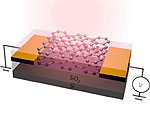Graphene Breakthrough could Lead to Night Vision Contacts
 Mar-20-14
Using graphene, researchers have developed an extremely thin, lightweight material able to detect infrared light—opening the door to the possibility of night-vision contact lenses or medical applications.
Mar-20-14
Using graphene, researchers have developed an extremely thin, lightweight material able to detect infrared light—opening the door to the possibility of night-vision contact lenses or medical applications.Although graphene can detect the entire infrared spectrum, it can only absorb a tiny amount of the light that hits it, which is not enough to generate an electrical signal and allow it function as an infrared sensor.
To boost the signal-generating capabilities of the material, the research team from the University of Michigan placed an insulator between two sheets of graphene. An electric current was run through the bottom sheet, while light hitting the top sheet caused electrons to be released and create positively charged electron holes. These holes then generated an electric field that changed the flow of current in the bottom layer, which could be measured by the researchers to determine how much light was hitting the top layer. The device can also function at room temperature, (previous attempts to increase the light detection of graphene required that the material be freezing) and researchers have already developed sensors as small as a contact lens.
More Info about this Invention:
[IEEE.ORG][UNIVERSITY OF MICHIGAN]

Add Your Comment